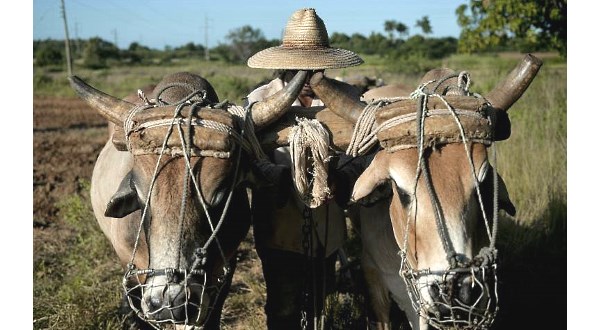
By Rigoberto DIAZ and Moises AVILA
Los Palacios (AFP) — A lack of fuel, in large part due to the US blockade, is forcing Cubans to return to horse and ox power for farming, transport and everyday travel.
In Los Palacios, 100 kilometres of the west of the capital Havana, Heriberto Piloto bellows at his oxen “Montezuelo” and “Pasajero” as they plough a tobacco field at the “La Juanita” farm.
Once the fields were ploughed by tractors, plus some animal help, but now beasts of burden are the only option, meaning the job of ploughman has made a comeback too in Cuba’s fields.
“Under normal conditions, we always used animals and… given the country’s fuel restrictions, we’ve had to increase this activity,” said Alfredo Reynoso, the director of the state company Cubaquivir, which provides services to the 12 agricultural cooperatives in Los Palacios.
“We need to prepare around 1,200 hectares (3,000 acres) of land with animal power during the cold season,” Reynoso added.
No buses
A thousand kilometres to the east, long, straight roads flanked by sugarcane fields lead to Havana.
There, “Dragau” and “Abre Campo” pull an ox cart driven by Felix Betancourt, a 65-year-old bringing food to field workers.
“I bring food to cooperative workers: breakfast, lunch. It works well, it saves a lot of things (including) fuel, given that there is none any more,” said Betancourt.
“The animals’ fuel is grass. In the evening I given them food, leave them to sleep well, then I get up the next morning and put them to work at 5:30 am.”
In the eastern city of Bayamo, horse-drawn carriages have long been a tourist attraction — today they’ve become an integral part of the public transport system.
“Carriages have always been used in Bayamo, but now they’re being used a bit more,” said Silvia Diaz, a neighbourhood leader.
“There are neighbourhoods where there are no buses, but there are carriages.”
Rides cost between two and five pesos (a maximum of 20 cents).
In recent weeks, garbage disposal has been carried out by carts pulled by animals.
“It’s helping to keep the neighbourhood clean and avoids fuel expenses,” she said.
Not enough beasts
US sanctions against Cuba and its main source of oil, socialist ally Venezuela, forced the island nation to operate with just 30 percent of its fuel needs in September.
October was better but still Cuba had only 60 percent of its requirements.
“You can’t say that the lack of fuel hasn’t been felt,” said Jorge Luis La Guardia, the 50-year-old president of one of Los Palacios’ agricultural cooperatives.
It’s not the first time that Cuba has had to revert to the use of pack and draught animals.
The government encouraged their use during the economic crisis of the 1990s that followed the break-up of the old Soviet Union, which had been Cuba’s main foreign backer.
The problem is that Cuba doesn’t have enough beasts to take up the strain of silenced engines.
Los Palacios has 780 pairs of oxen, “insufficient” to meet the city’s needs, according to Reynoso.
“We’re transporting 100 percent of the farmers’ food to the population by pack animals, with oxen and carts, horse gigs and horse-drawn carriages,” said La Guardia.
Cuba has almost 200,000 pack animals, according to official data.
Back in the fields, weighing in at more than 600 kilograms each, “Montezuelo” and “Pasajero” follow 54-year-old Piloto’s orders.
“The technique is to get up early, and at around 10-something or 11 am, if it’s a hot morning, you let the ox loose, give it food, and then at 4-something in the afternoon, you put them back to work,” said Piloto, his skin weather-beaten.
“Anyone would want a tractor, but it’s impossible.”
ADVERTISEMENT
ADVERTISEMENT


































